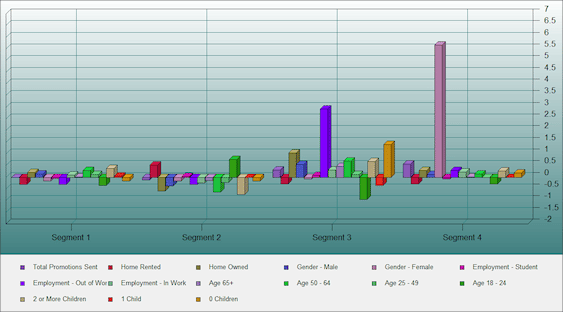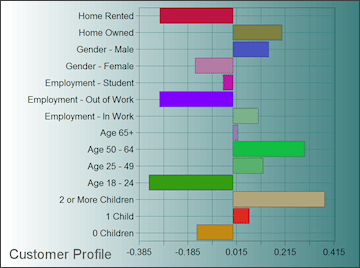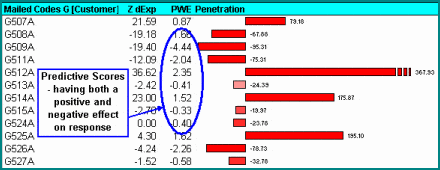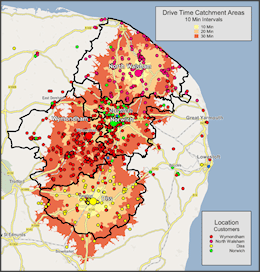The science behind customer profiling and customer segmentation can send even the most seasoned statistical veterans into a spin.
If you want to understand the differences between your customers, what makes people respond positively to your sales messages vs. what makes people leave your brand, data analysis based on profiling and segmentation could hold the key.
In this post we deconstruct two of the most common statistical techniques: customer profiling and customer segmentation.
Customer Segmentation
People or organisations with one or more characteristics that cause them to demand similar products and/or services – based on the qualities of those products such as price or function, can be grouped into what is termed a segment.
A true market segment is distinct from other segments (different segments have different needs), is homogeneous within the segment (exhibits common needs), responds similarly to a market stimulus, and can be reached by a market intervention.
The term is also used when consumers with identical product and/or service needs are divided up into groups so they can be charged different amounts. 
People in a given segment are supposed to be similar in terms of criteria by which they are segmented, and different from other segments in terms of these criteria.
These can broadly be viewed as ‘positive’ and ‘negative’ applications of the same idea, splitting up the market into smaller groups.
Customer segmentation is a form of critical evaluation rather than a prescribed process or system, and hence no two markets are defined and segmented in the same way. However there are a number of foundation criteria that assist segmentation:
- Is the segment viable and can you make a profit from it?
- Is the segment accessible?
- How easy is it to get into the segment?
- Is the segment measurable?
- Is realistic data obtainable to consider its potential?
The are many ways that a segment can be considered, and some of the basics include:
- Geography or Territory – such as where in the world was the product or service bought.
- Psychographics – such as lifestyle or beliefs.
- Socio-cultural factors – such as class.
- Demography – such as age, sex…, and for business, size, turnover, industry type…, and so on.
Opportunities will depend upon factors such as the potential growth of the segment, the state of competition within the segment, how much profit the segment will deliver, how large the segment is, and how the segment fits with the current direction of the company and its vision.
[pullquote style=”left” quote=”dark”]A company should evaluate each segment based upon potential business success.[/pullquote]
Customer Profiling
Customer profiling your customers in essence refers to identifying the characteristics that are needed to target sales and marketing campaigns.

- Evaluate market potential.
- Develop appropriately balanced sales and franchise territory areas.
- Identify where to locate new outlets in site location planning.
- Identify hot spots to target sales effort.
- Tailor messages within sales and marketing communications making them relevant to their intended target.
It goes deeper though to differentiate your best and most loyal customers – those that buy more frequently, place higher value orders and are open to other offers – from the rest.
Not all customers are ideal – some will purchase infrequently, won’t spend a great deal of money or will have little loyalty, yet will take a lot of your selling time.
One approach to customer profiling is to first segment – or group – customers by their value to the business, then append external profile data – census, lifestyle, market data or business/consumer geo-demographics – to enrich customer segmentation and customer understanding. 
To do this we first statistically analyse customer trading data to determine how much people spend, how often they buy, what they buy, where they live, their life stage, what attracted them to your company, etc., then compute a score to identify the ‘best’ type of customer.
Using the Postcode (or ZIP code), we add external ‘profile’ data which allows us to accurately describe what your best customers look like.
Then, using geographic analysis techniques, we can position your existing customers on a map – classifying by value – and develop what is termed a ‘heat map’ to identify where geographically to find more of the same.
[pullquote style=”left” quote=”dark”]Customer profiles enable you to target the right people using the right media and channel.[/pullquote]
Application
What to do with this new found information? For starters, if you are planning a product launch, moving into franchising or thinking of expanding into a new geographic area, by applying some mathematics and a ‘weighting’ to take account of known competition and the brand life stage, you can estimate what a specific geographic area may deliver in terms of sales 
Add to this your knowledge of the effort needed to sell your product or service and a realistic estimate of how many prospects (or customers) a sales team could cope with, and this information can be used as the basis to compute a set of ‘right-sized’ sales or franchise territories, balanced by opportunity and drive time.
Territories created in this way will deliver economic benefits, prevent territory owners/sales teams being located too close to one another or located in unsuitable areas, and ensure each has sufficient territory to generate a revenue stream without undue competition.
If you operate a location based business model, then choosing the right site to open your outlet has as much to do with the demographic profile of your customers as it does the physical location of the outlet.
With accurate customer profiling and people or businesses grouped by segment, the right analytical resource, tools and data – including competitor locations, traffic patterns, parking, high target market density – you will be able to determine how many outlets or branches you can open in an existing market, where you should expand your network, which outlets should be closed or consolidated.
You will also be able to select the outlet, branch or other business locations that are profitable and contribute strongly to your overall network. Perhaps most importantly, customer profiling enables you to target the right people using the right media and channel to get across your marketing and sales messages.
If you would like to find out how customer profiling and customer segmentation could benefit your business or maybe already have a model and would like to see how it could be improved please get in touch with one of our skilled team members today!
